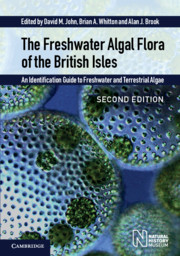 The Freshwater Algal Flora of the British Isles
The Freshwater Algal Flora of the British Isles Published online by Cambridge University Press: 12 January 2024
The study of freshwater dinoflagellates in the British Isles has been sporadic and partial. The majority of work describing species and their ecology took place between 1920 and 1960. Workers of note were the Wests (e.g. W. and G.S. West, 1906) and Harris (1940). Since that time there have been some detailed studies on individual genera, most notably Ceratium in the English Lake District (Chapman et al., 1981, 1985; Heaney et al., 1983, 1988), but little further descriptive work. As far as possible, all historical accounts of records for the British Isles have been brought together in the production of the present account, which aims to describe all the species recorded. However, it is likely that many more species remain to be discovered; indeed, in the course of writing this account a number of hitherto unrecorded species were found. So the keys provided here should be used with caution. Whilst they cover the species most likely to be found, studies on new water bodies may well lead to the discovery of species not described here. If an organism does not conform to any of the descriptions here, the most useful accounts for trying to identify it are those of Huber-Pestalozzi (1950) and Popovský and Pfeister (1990).
Dinoflagellates are characterized by their nucleus, which is distinctive by virtue of the permanently condensed chromosomes. Under the light microscope the nucleus frequently appears rather large in proportion to the cell and with obvious sausage-shaped chromosomes. Where the attribution of a cell is in doubt it is always worth checking this point, as a number of unusual cell forms exist within the class. However, the most common form for dinoflagellates is a motile unicell, often with a defined groove (cingulum) encircling the cell body, and with two dissimilar flagella. One transverse flagellum is placed within the cingulum and the other, longitudinal, follows a second groove (sulcus) at right angles to the cingulum. These flagella produce a characteristic whirling swimming motion from which the name dinoflagellate is derived. The cell wall consists of vesicles, which in various genera contain differing amounts of cellulosic material. These vary from strongly armoured species, which have relatively thick plates, to those with little reinforcement, which are referred to as unarmoured. Under the light microscope these differences may be very evident, the armoured forms having strongly ornamented, angular outlines which are retained even after lengthy examination.
To save this book to your Kindle, first ensure [email protected] is added to your Approved Personal Document E-mail List under your Personal Document Settings on the Manage Your Content and Devices page of your Amazon account. Then enter the ‘name’ part of your Kindle email address below. Find out more about saving to your Kindle.
Note you can select to save to either the @free.kindle.com or @kindle.com variations. ‘@free.kindle.com’ emails are free but can only be saved to your device when it is connected to wi-fi. ‘@kindle.com’ emails can be delivered even when you are not connected to wi-fi, but note that service fees apply.
Find out more about the Kindle Personal Document Service.
To save content items to your account, please confirm that you agree to abide by our usage policies. If this is the first time you use this feature, you will be asked to authorise Cambridge Core to connect with your account. Find out more about saving content to Dropbox.
To save content items to your account, please confirm that you agree to abide by our usage policies. If this is the first time you use this feature, you will be asked to authorise Cambridge Core to connect with your account. Find out more about saving content to Google Drive.